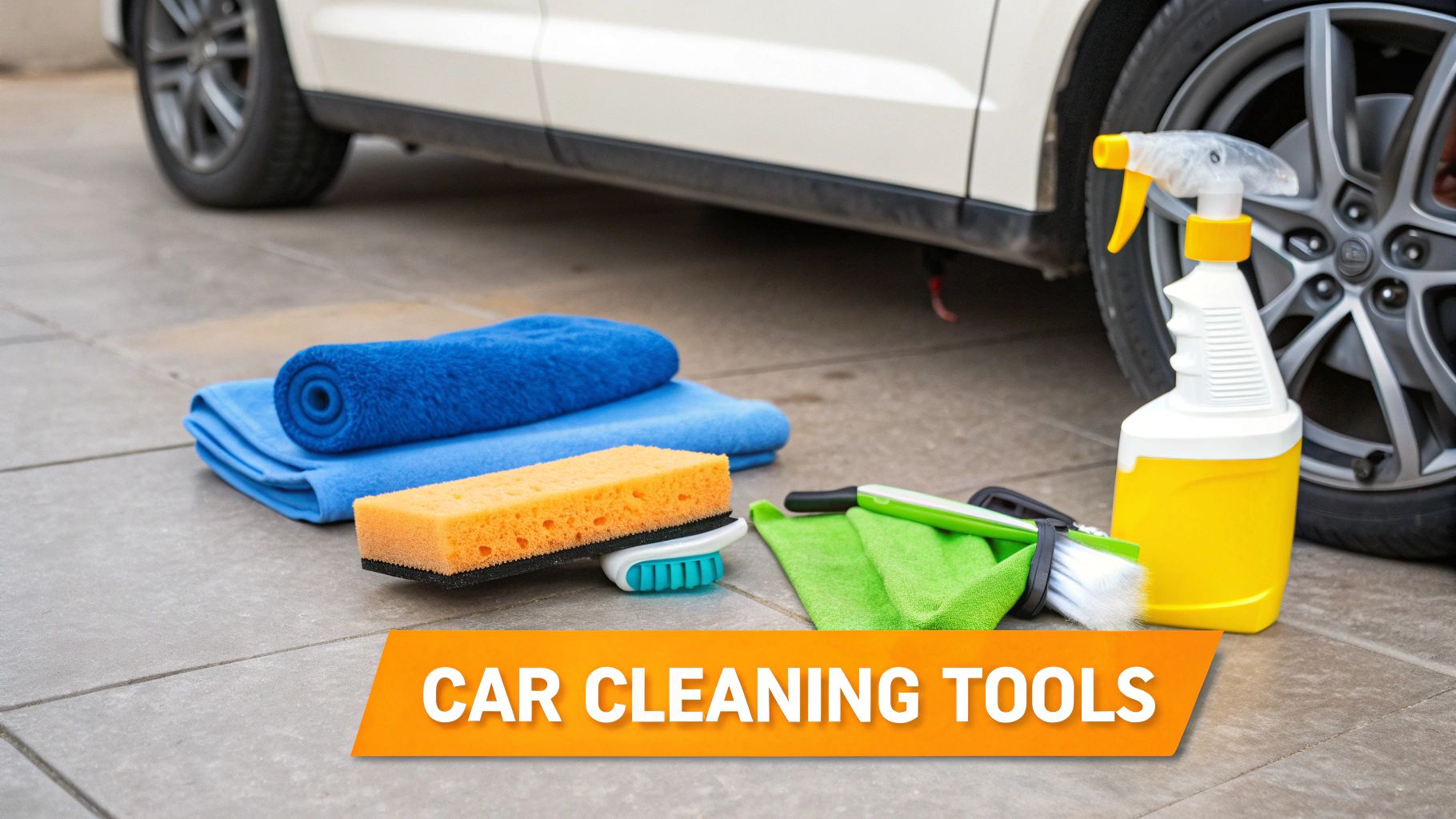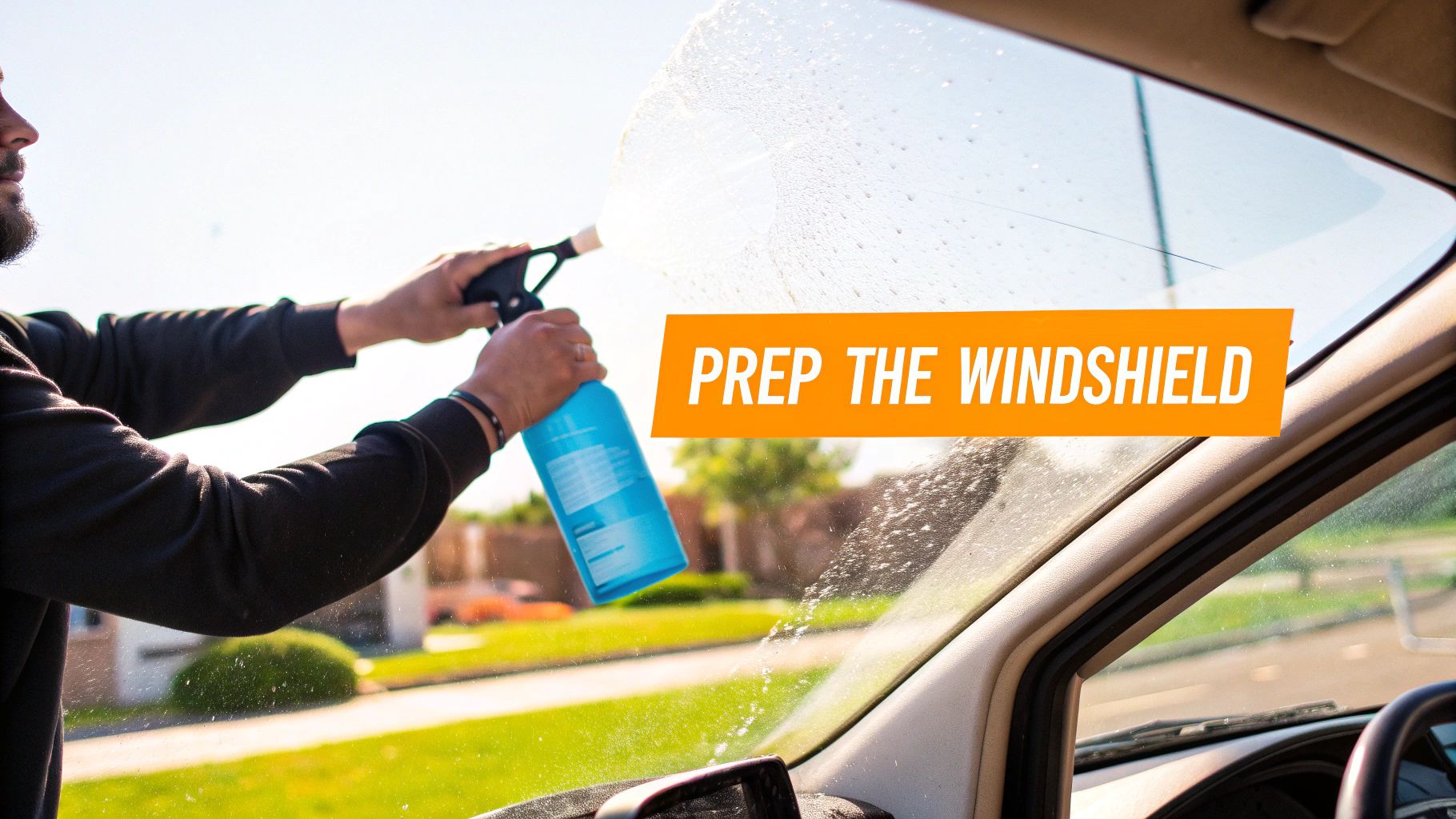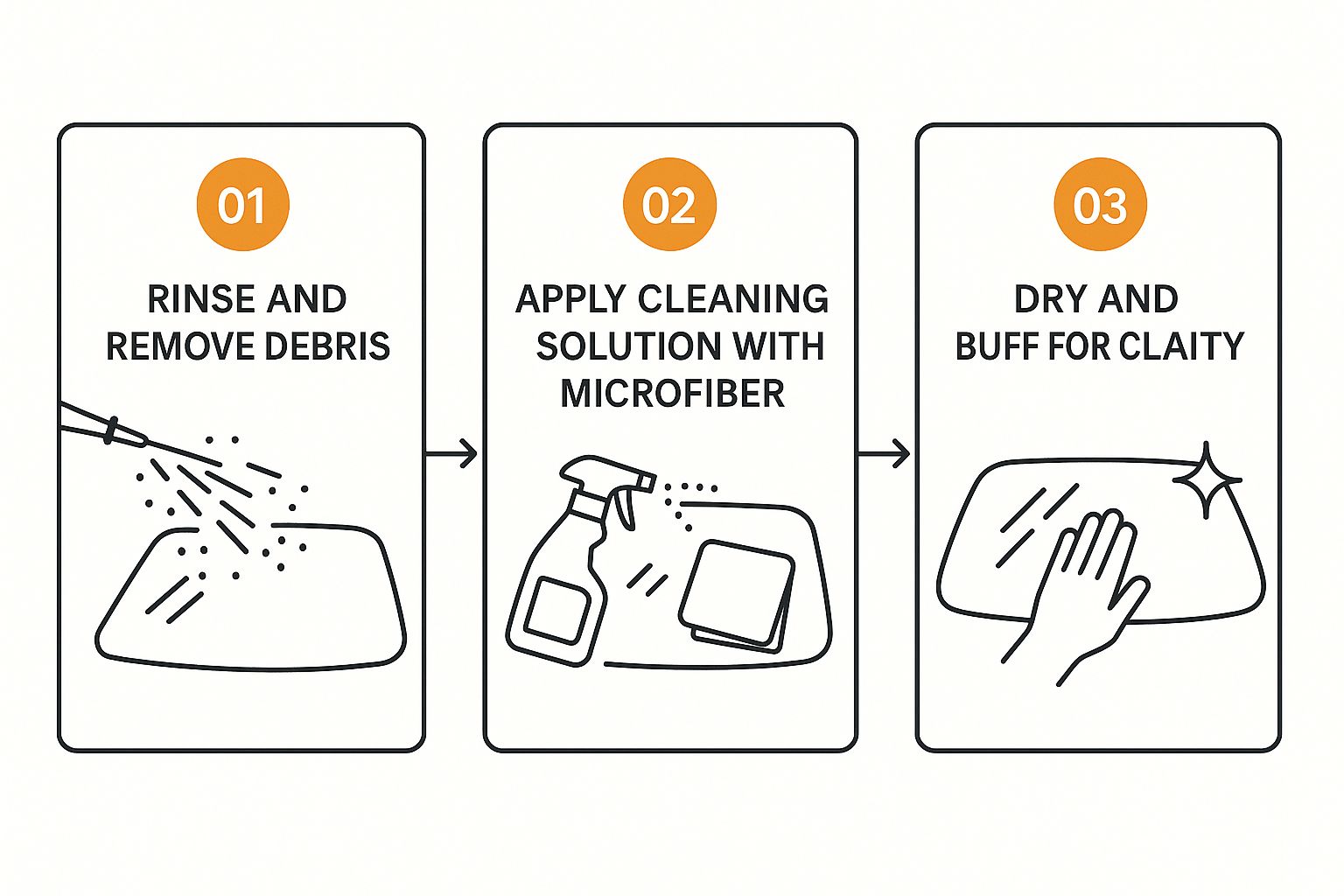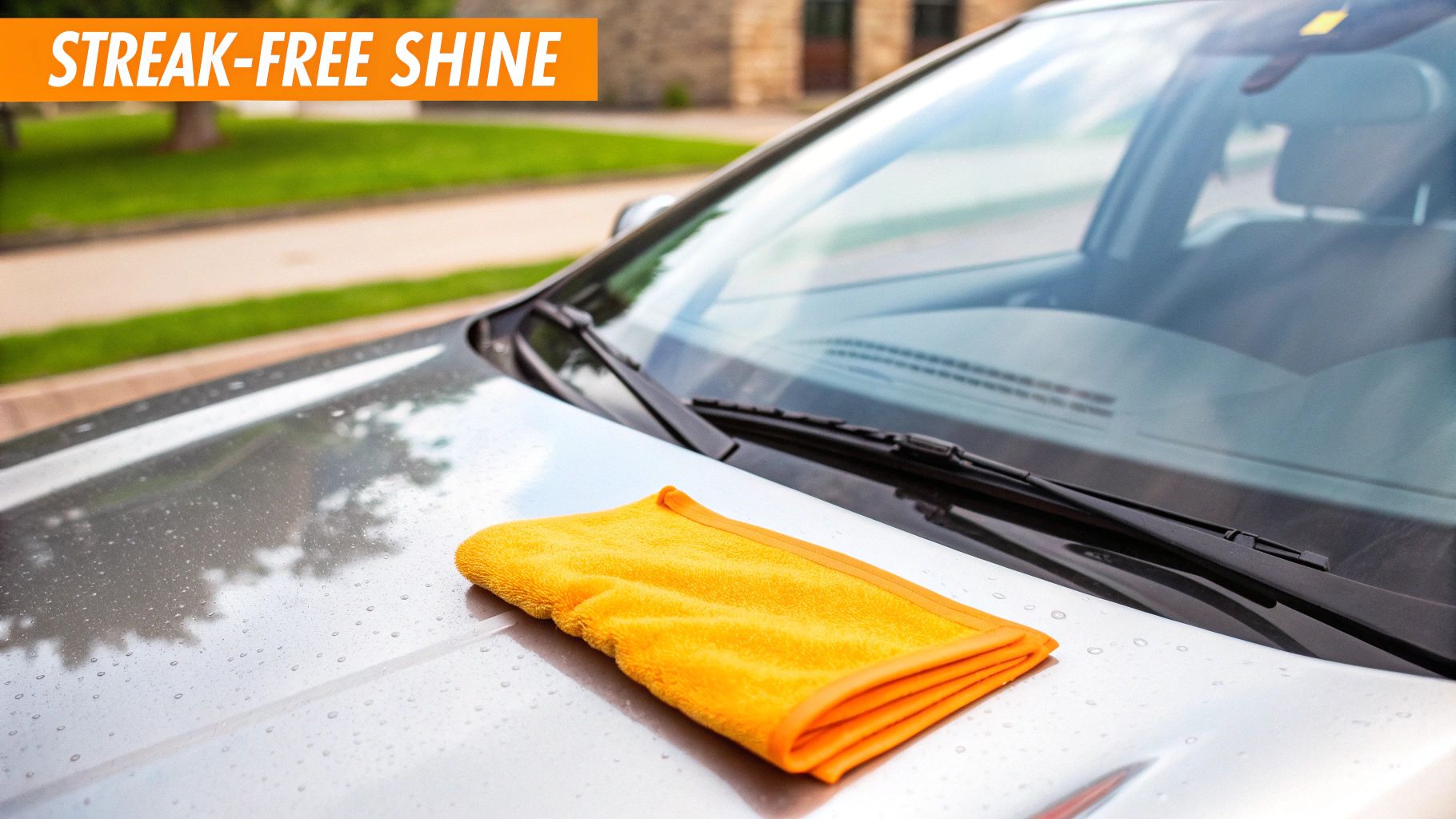If you want to know the absolute best way to clean a car windshield, it boils down to one simple, professional-grade technique: the two-towel method. You'll need a quality, ammonia-free automotive glass cleaner, one microfiber towel for cleaning, and a second, completely dry one for buffing. This separation of tasks is the secret to getting that crystal-clear, streak-free finish.
Why a Perfect Windshield Matters More Than You Think

We've all been there. You spend time scrubbing your windshield, only to drive into the sun and see a mess of hazy streaks. It's incredibly frustrating, and that glare can be genuinely blinding. The problem usually isn't how hard you're working, but the method you're using. It’s time to toss out the paper towels and stop scrubbing in circles.
This guide will show you how to get that "invisible glass" look every single time. The core principle is simple: you need to separate the cleaning step from the drying and buffing step. That’s why the two-towel method is a complete game-changer for both the inside and outside of your glass.
The Foundation of a Flawless Finish
Getting this right is about more than just making your car look good; it's a critical part of safe driving. A perfectly clear windshield allows you to spot and react to hazards on the road, especially in tough conditions like rain or at dusk.
Many of the core principles for automotive glass apply to other surfaces, too. For a deeper dive into techniques, exploring the best way to clean windows for a perfect shine can give you some great foundational knowledge.
The goal is to make streaks and haze a thing of the past. By adopting a professional method, you ensure your time and effort result in a perfectly clear and safe view every single time you get behind the wheel.
It's clear that drivers everywhere are looking for better solutions. The global market for windshield cleaners was already valued at $2.3 billion in 2022 and is expected to climb to $3.4 billion by 2030. This massive market shows just how many of us are trying to achieve better clarity and safety on the road.
Gathering Your Windshield Cleaning Toolkit

Getting that perfectly invisible glass finish isn't about scrubbing harder—it’s about working smarter with the right equipment. I've seen it a thousand times: someone grabs a worn-out t-shirt and a bottle of Windex, and the result is a guaranteed recipe for a streaky, lint-covered mess.
The difference between a professional result and a frustrating afternoon often comes down to what's in your detailing bucket. Think of it like cooking a gourmet meal. Even the best chef can't create a masterpiece with dull knives and subpar ingredients. It's the exact same story when it comes to getting your windshield truly clean.
Why Your Towel Choice Is Everything
If there's one tool that makes or breaks the job, it's your towel. Seriously. Forget paper towels—they just shred and leave lint everywhere. And those old cotton rags? They do little more than smear grime around.
The undisputed champion for glass cleaning is the microfiber towel.
Their unique, split-fiber construction is what makes them so special. They create an almost magnetic charge that physically lifts and traps dust, oils, and dirt particles instead of just pushing them across the glass. This is the secret to a residue-free wipe.
For a genuinely streak-free result, you'll need at least four clean towels on hand:
- Two for the exterior: One for the initial clean and scrub, and a second, bone-dry towel for the final buff.
- Two for the interior: A dedicated pair for the inside is crucial. This prevents you from accidentally transferring oily road film and bug guts onto your dashboard and interior surfaces.
The quality of these towels matters more than you'd think. To really understand what makes them so effective and what to look for, check out this guide on the best microfiber towels for car detailing. Mastering this one detail will completely change your results.
Selecting The Right Cleaning Solution
Once you have your towels sorted, you need a liquid that can do the heavy lifting. The store shelves are packed with options, but they're definitely not all created equal. The goal is to find a formula that's tough on grime but gentle on your car's delicate surfaces.
Choosing the right cleaner is crucial. Here’s a breakdown of common options to help you select the best one for a streak-free result.
Windshield Cleaning Solution Comparison
| Solution Type | Pros | Cons | Best For |
|---|---|---|---|
| Automotive Glass Cleaner | Ammonia-free, safe for tint & trim, cuts through road film and vinyl fog | Can be more expensive than household options | The safest and most effective choice for all car windshields, inside and out. |
| Isopropyl Alcohol (IPA) Solution | Excellent for cutting through oily residue and stubborn films | Must be diluted properly (e.g., 50/50 with distilled water), can be harsh if too concentrated | Pre-cleaning stubborn interior film or removing adhesive residue before the main wash |
| Distilled Water & Vinegar | Inexpensive, readily available, chemical-free | Less effective on heavy grime like bug splatter or sap, vinegar smell can linger | Light-duty cleaning or a final rinse to ensure no mineral spots are left behind |
| Household Glass Cleaner | Widely available, often inexpensive | Often contains ammonia, which can damage window tint, rubber seals, and plastics | Not recommended for automotive use. |
The biggest takeaway here is to avoid the temptation of grabbing whatever is under your kitchen sink.
The most significant mistake drivers make is grabbing a household glass cleaner. Many of these products contain ammonia, a chemical that will damage window tint, dry out the rubber seals around your windshield, and even discolor your dashboard if oversprayed.
Always, always opt for an automotive-specific, ammonia-free glass cleaner. They are formulated to tackle the unique gunk we find on cars—road film, bug splatter, and that hazy vinyl fog that builds up inside—all without harming sensitive materials.
Mastering Your Exterior Windshield Technique
Cleaning the outside of your windshield is a whole different ballgame. You're up against a baked-on mess of bug guts, road grime, sticky tree sap, and whatever else the environment throws at you. A quick car wash barely makes a dent. If you want that invisible, perfectly clear glass, you have to get this surface truly clean.
Before a single drop of cleaner touches the glass, the most critical step is prep. Give the windshield a quick, gentle rinse with a hose or a bucket of plain water. This isn't just about getting it wet; it's about flushing away all the loose dirt and grit that will act like sandpaper under your towel and scratch the glass. Think of it as clearing the deck before the real work begins.
Taking it to the Next Level with a Clay Bar
Ever wash your car and still feel a rough, gritty texture on the glass? That’s bonded contamination—things like industrial fallout or sap—and your regular glass cleaner won’t touch it. This is where a detailing tool called a clay bar comes into play.
Using a clay bar on your windshield might sound like something only the pros do, but it's incredibly simple and the results are amazing.
- Lube is your friend. Keep the glass wet from your initial rinse, or use a dedicated clay lubricant spray. Never use a clay bar on a dry surface.
- Let the clay do the work. Just glide the bar over the glass in straight lines. I usually go top-to-bottom, then side-to-side. No need to apply heavy pressure.
- You'll feel the difference. At first, you’ll feel the clay grabbing and catching. As it pulls the embedded gunk out of the glass, it will start to glide smoothly. That's how you know it's working.
This extra step makes the surface perfectly smooth. Your glass cleaner will work better, and your wiper blades will glide silently instead of chattering and skipping across the glass.
A lot of people think that if a windshield looks clean, it is clean. That’s a common mistake. Bonded contaminants are often invisible, but they create a surface that attracts more dirt and is the root cause of streaking. A clay bar is the only way to get your glass clean on a microscopic level.
This infographic breaks down the core process for getting that streak-free shine.

As you can see, a methodical approach—prepping, deep cleaning, and buffing—is what separates a quick wipe-down from a professional finish.
The Two-Towel Wiping Method
Alright, with the prep work done, it's time to clean. A quick but important tip: always work on a cool windshield in the shade. If the glass is hot, your cleaner will evaporate almost instantly, leaving a streaky mess behind.
Grab your two clean microfiber towels and a quality automotive glass cleaner.
Start by liberally spraying the cleaner onto one half of the windshield. The key to avoiding smears is a consistent wiping pattern. Use straight, vertical strokes from the top down to the bottom. This ensures you cover every inch without creating the circular haze that shows up in the sunlight.
Don't let it dry. Immediately grab your second, completely dry microfiber towel and get to buffing. This time, wipe with straight, horizontal strokes. This cross-hatch pattern (one towel vertical, one towel horizontal) is the secret to lifting every last trace of cleaner and moisture, which are the real culprits behind streaks. Once that side is perfect, repeat the whole process on the other half.
This dedication to a crystal-clear view is a big deal. The global market for windshield cleaning concentrates was valued at around $2.5 billion in 2025 and is on track to hit nearly $3.5 billion by 2033. That’s a lot of drivers who understand that a clean windshield is a safety essential. You can find more data about the growing demand for quality automotive cleaners in this report from Archive Market Research.
How to Clean the Inside of Your Windshield

Cleaning the inside of your windshield is a totally different ballgame. The outside gets pelted with bugs, rain, and road grime, but the inside wages a subtle war against a stubborn, hazy film that seems to materialize out of thin air. You know the one—it becomes blinding the second the sun hits it at the wrong angle or a pair of headlights shines through.
So, what is that frustrating film? It’s caused by a process called off-gassing. Over time, the plastics, vinyl, and other materials in your car’s cabin—especially the dashboard baking in the sun—release chemical compounds. These compounds float around and eventually settle on your glass, creating an oily, hard-to-remove residue. Getting rid of this car windshield haze for good requires a specific, methodical approach.
The Prep and Positioning Strategy
First things first, get comfortable. Hop over to the passenger seat. Trust me, this vantage point gives you much better leverage and reach across the entire windshield, which is otherwise an awkward and frustrating task from the driver's side.
Before you even think about cleaner, grab a clean, dry microfiber towel and give the entire glass surface a quick wipe-down. This picks up all the loose dust and prepares the glass for a proper cleaning.
Now for the most important rule of interior glass cleaning: never spray cleaner directly onto the windshield. It's a rookie mistake that sends overspray all over your dashboard, which can stain or damage the finish. Instead, lightly mist your cleaning towel, not the glass. This simple habit gives you total control and prevents a mess.
Don’t try to be a hero and clean the whole windshield at once. The angle is just too awkward, and you're guaranteed to miss spots and end up with streaks. It’s far more effective to work in sections—tackle the driver's side first, then move to the passenger's side.
This kind of careful technique is a big reason why the automotive care industry is so massive. In fact, the global market for automotive windshield washer systems hit an incredible $20.48 billion in 2023. That number shows just how much people value crystal-clear visibility. You can see the full analysis in this automotive washer systems report from SNS Insider.
Executing the Two-Towel Technique
This is where the magic happens. The two-towel method is non-negotiable for a streak-free finish.
Take your first towel (the one you lightly misted with cleaner) and wipe down your first section of the glass. Use firm, overlapping strokes, either vertically or horizontally. When you get to those tough-to-reach corners where the glass meets the dash, here’s an old detailer’s trick: press the towel into the corner using the back of your hand. This gives you better pressure and control right up to the very edge.
As soon as you’ve wiped the section down, immediately grab your second, completely dry microfiber towel. This is your buffing towel. Go over the exact same area with clean, straight strokes to pick up any leftover moisture or cleaner residue. This final buff is what truly eliminates streaks and leaves the glass looking invisible.
Mastering this is a cornerstone of a truly immaculate interior. For more tips on keeping your cabin pristine, take a look at our guide on 7 pro car interior cleaning tips for 2025.
Just repeat this clean-and-buff process on the other half of the windshield, and you'll have finally conquered that annoying interior haze.
Pro Tips for Keeping That View Crystal Clear
Getting that perfect, streak-free windshield feels great, but keeping it that way is the real win. A flawless cleaning job can be ruined by a single rainstorm if your car's own systems are working against you. The secret isn't more scrubbing; it's about smart, proactive maintenance that keeps your glass looking good for the long haul.
Think of it as prevention. By giving a little attention to a few key parts and adding a protective layer, you can keep your windshield cleaner for weeks at a time, even when the weather isn't cooperating.
It All Starts with Your Wiper Blades
Your wiper blades are easily the most important factor in your day-to-day visibility. If they're old, cracked, or just plain dirty, they’re just smearing a film of grime across your line of sight every time you use them. See streaks during a rain shower? Your blades are almost always the culprit.
Giving them a quick check is easy. Just lift the wiper arm away from the glass and run your finger along the rubber edge. If you feel any nicks, hard spots, or brittleness, it's time for a new pair. Most auto parts stores can look up the right size for your car, and swapping them out is usually a simple DIY job.
My Go-To Tip: Even brand-new wiper blades can have a thin film on them from the factory. Before you install them, grab a clean microfiber towel, put a little rubbing alcohol on it, and give the rubber edge a quick wipe. This little trick removes that residue and ensures you get a perfectly clean sweep from the very first use.
Add a Layer of Protection
Honestly, one of the best things you can do for your windshield is to apply a glass sealant or a hydrophobic coating. These products work by creating an invisible, super-slick surface on the glass that completely changes how water behaves on it.
Instead of water sheeting across the glass and blurring your view, it beads up into tiny, tight droplets that just roll right off, especially once you're driving at speed. This gives you two huge advantages:
- Better Visibility: Driving in the rain is suddenly much safer and less stressful because your view stays so much clearer.
- A Self-Cleaning Effect: As those water beads roll away, they take dirt and dust with them. It’s amazing how much cleaner the windshield stays between washes.
Putting it on is usually as simple as wiping the liquid onto your clean glass, letting it haze up for a few minutes, and then buffing it off. This one easy step can keep your windshield protected for months. Of course, if you have stubborn mineral deposits already, you'll want to tackle those first. Learning how to remove water spots from your windshield is a crucial prep step before sealing the glass.
Pick the Right Washer Fluid
Last but not least, don't just grab the cheapest blue stuff at the gas station. While it's better than plain water, spending a few extra bucks on a quality washer fluid can make a noticeable difference.
Look for formulas with additives for bug removal or ones that contain water-repellent properties. These are designed to break down road grime and splattered insects much more effectively, turning your car's own washing system into a powerful maintenance tool.
Your Top Windshield Cleaning Questions Answered
Even after you’ve got the basics down, a few tricky questions always seem to surface. Honestly, mastering these little details is what takes you from a decent car wash to that perfectly invisible, streak-free glass. Let's tackle some of the most common things people ask so you can nail the perfect finish every time.
Knowing the why behind a certain rule—like why one cleaner is better than another—is what really levels up your detailing game. It helps you make smarter choices on the fly.
Can I Just Use Windex on My Car Windshield?
This is probably the number one question I get, and the answer is a hard no. Please, step away from the household glass cleaner when it comes to your car.
The big problem is ammonia. Most of those blue cleaners you use around the house are full of it, and it’s terrible for your vehicle. Over time, ammonia will dry out and damage the rubber seals and plastic trim around your windshield, causing them to crack and age prematurely. Worse, if you have tinted windows, it's a death sentence for the film—it'll cause bubbling, peeling, and discoloration.
Pro Tip: Always grab a dedicated, ammonia-free automotive glass cleaner. They’re specifically designed to cut through road grime, bug guts, and sap without damaging the more sensitive materials in and around your car.
What’s Causing That Hazy Film on the Inside of My Windshield?
Ah, the dreaded interior haze. That greasy film that seems to appear out of nowhere and makes driving into the sun a blurry nightmare. This is caused by a natural process called off-gassing.
Think about all the plastics, vinyls, and adhesives that make up your car's dashboard and interior. As they age, and especially when they bake in the sun, they slowly release chemical compounds into the air. These compounds float around and eventually settle on the coolest surface they can find: the inside of your glass. That's your haze.
This film can also be made worse by:
- Smoking or vaping inside the car
- Moisture buildup from just breathing
- Dust and oils from your hands touching the dash and glass
There’s no magic bullet here. The only way to keep that film from building up and messing with your visibility is to clean the interior glass regularly using that two-towel method we talked about.
How Do I Get Rid of Caked-On Bugs and Tree Sap?
Every now and then, you’ll run into something that a normal spray-and-wipe just won't touch. For those seriously stubborn spots like baked-on bug splatter or sticky tree sap, you need to bring in a specialist.
Your best weapon against bugs and tar is a dedicated bug and tar remover. These sprays are engineered to dissolve the proteins and sticky stuff without forcing you to scrub and risk scratching the glass. For fresh, gooey tree sap, a little bit of isopropyl (rubbing) alcohol on a microfiber cloth usually does the trick.
Here’s the key, though: you have to spot-treat these areas first. Once the gunk is gone, you absolutely must re-clean the entire windshield with your regular glass cleaner. This final pass removes any residue from the spot-treatment chemicals and ensures you get that uniform, streak-free shine across the whole surface.
Is It Better to Clean My Windshield in the Sun or the Shade?
This one is simple, but it makes all the difference: always, always clean your windshield in the shade.
When you work in direct sunlight, the glass gets hot—sometimes incredibly hot. Spraying cleaner on a hot surface causes it to evaporate almost instantly. This gives you zero time to actually wipe away the dirt and properly buff the surface. Streaks aren't just likely; they're practically guaranteed.
Working on a cool, shaded surface gives you total control. The cleaner has time to break down the grime, and you have enough time to go through your wiping and buffing steps without rushing. It’s the secret to a flawless finish.
Ready to make car washing easier and more effective? The SwiftJet Car Wash Foam Gun connects to any standard garden hose to cover your vehicle in thick, dirt-lifting foam. Achieve a professional-level clean at home. Get your SwiftJet today and experience the difference
